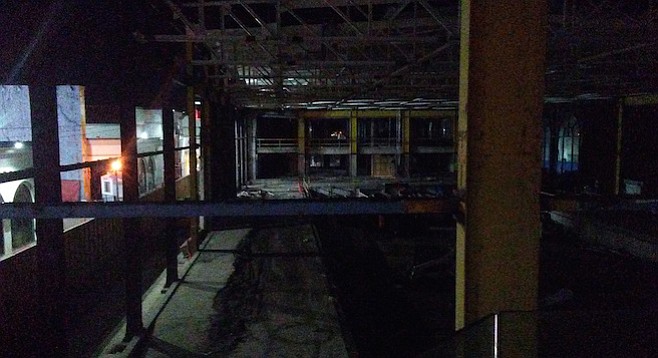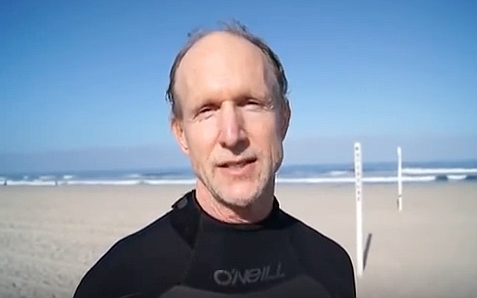 Facebook
Facebook
 X
X
 Instagram
Instagram
 TikTok
TikTok
 Youtube
Youtube

“They can do it fast or they can do it right,” says Dawn Reilly as she looks at the skeletal framing that remains from the Belmont Park building that holds the Plunge swimming pool. “It’s awesome that they decided to do it right.”
The Plunge, the gorgeous extra-large swimming pool just east of the ocean in Mission Beach, looks skeletal these days. All the concrete and tile are gone from the pool and the decks around it are scored and cut to the ground in places. You know this because the building that enclosed it is gone but for the framing and the beams across the top.
“We are taking it down to the ground,” says Dariel Walker for Pacifica Enterprises. “We’ll be doing demolition work until we stop for summer and then we’ll start construction when summer ends.”
John Spreckels built the Plunge and the amusement park around it in 1925. The Mission Beach Amusement Park eventually became known as Belmont Park and its history includes being shuttered a few times, including being closed in 1976 and then nearly closed and the land sold for development in 1986. It took the Save Our Heritage Organisation and then mayor Maureen O’Connor’s efforts to preserve the site.
In 1988, the city entered into a 50-year lease that changed hands many times before it landed with Pacifica.
The city and previous landlord, Tom Lochtefeld (beginning in 2000), parted ways after Lochtefeld shut down the Plunge over problems with the buildings. Lochtefeld said that what he owed the city for rent was supposed to go to repairing problems with the Plunge as rent credits, but the city decided not to keep its end of the deal.

Lochtefeld closed the Plunge in 2011, while the other amusement-park amenities remained.
In 2013, Pacifica Enterprises took over the lease and offered to pay to restore the building and pool — the city’s responsibility — and then take the money out of the rent they agreed to pay. The company agreed to pay $900,000 per year along with a percentage of revenue from the restaurants, rides, and merchandise sales; a minimum increase of 2.5 percent once every three years, according to city documents. The company initially expected to pay about $1.2 million in restoration costs for the Plunge; the estimates last year were up to about $5.9 million. Like Lochtefeld, rent credits for repairs are written into the lease.
Pacifica plans an aluminum-and-glass design to help protect the structure from the ocean, whose proximity makes most building materials disintegrate much faster than they normally would. It will have a retractable roof and the swimming pool will be restored. The marine mammal mural on the south wall was dismantled and will go back up, according to Pacifica engineer Dan Hayden.
The Mission Beach Precise Planning Board unanimously approved the plan.
So far, cost estimates have run to well over $6 million, but with each layer scraped off, the costs go up. The company set out to keep the pool’s original tile; they did manage to preserve a lot of it, but some did break and they found they were going to have to have replacement tile custom-made.
The company has reputedly worked closely with historical experts and with the community, sending staffers to dozens of community meetings to let people know what’s going on.


“They can do it fast or they can do it right,” says Dawn Reilly as she looks at the skeletal framing that remains from the Belmont Park building that holds the Plunge swimming pool. “It’s awesome that they decided to do it right.”
The Plunge, the gorgeous extra-large swimming pool just east of the ocean in Mission Beach, looks skeletal these days. All the concrete and tile are gone from the pool and the decks around it are scored and cut to the ground in places. You know this because the building that enclosed it is gone but for the framing and the beams across the top.
“We are taking it down to the ground,” says Dariel Walker for Pacifica Enterprises. “We’ll be doing demolition work until we stop for summer and then we’ll start construction when summer ends.”
John Spreckels built the Plunge and the amusement park around it in 1925. The Mission Beach Amusement Park eventually became known as Belmont Park and its history includes being shuttered a few times, including being closed in 1976 and then nearly closed and the land sold for development in 1986. It took the Save Our Heritage Organisation and then mayor Maureen O’Connor’s efforts to preserve the site.
In 1988, the city entered into a 50-year lease that changed hands many times before it landed with Pacifica.
The city and previous landlord, Tom Lochtefeld (beginning in 2000), parted ways after Lochtefeld shut down the Plunge over problems with the buildings. Lochtefeld said that what he owed the city for rent was supposed to go to repairing problems with the Plunge as rent credits, but the city decided not to keep its end of the deal.

Lochtefeld closed the Plunge in 2011, while the other amusement-park amenities remained.
In 2013, Pacifica Enterprises took over the lease and offered to pay to restore the building and pool — the city’s responsibility — and then take the money out of the rent they agreed to pay. The company agreed to pay $900,000 per year along with a percentage of revenue from the restaurants, rides, and merchandise sales; a minimum increase of 2.5 percent once every three years, according to city documents. The company initially expected to pay about $1.2 million in restoration costs for the Plunge; the estimates last year were up to about $5.9 million. Like Lochtefeld, rent credits for repairs are written into the lease.
Pacifica plans an aluminum-and-glass design to help protect the structure from the ocean, whose proximity makes most building materials disintegrate much faster than they normally would. It will have a retractable roof and the swimming pool will be restored. The marine mammal mural on the south wall was dismantled and will go back up, according to Pacifica engineer Dan Hayden.
The Mission Beach Precise Planning Board unanimously approved the plan.
So far, cost estimates have run to well over $6 million, but with each layer scraped off, the costs go up. The company set out to keep the pool’s original tile; they did manage to preserve a lot of it, but some did break and they found they were going to have to have replacement tile custom-made.
The company has reputedly worked closely with historical experts and with the community, sending staffers to dozens of community meetings to let people know what’s going on.
Comments